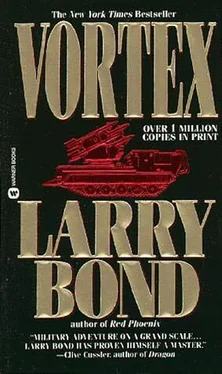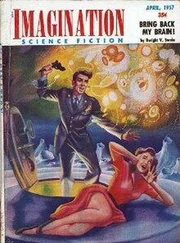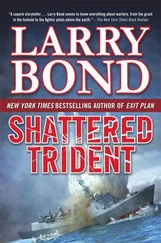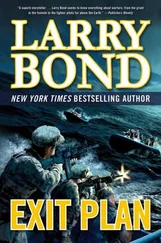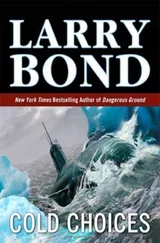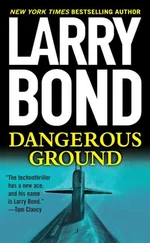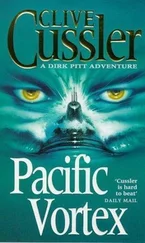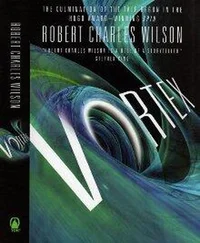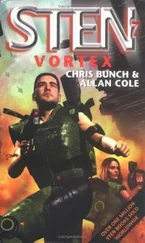O’Connell watched them go and turned to the rest of his able-bodied headquarters troops. There weren’t many. Maybe half of those who’d jumped.
He made a quick count. Seven officers and roughly twenty enlisted
Rangers-and with only two M60s for support. He shook his head, impatient with his own pessimism. He’d have to make do.
“Okay, let’s mosey on down this trench and see what the hell’s holding up Bravo Three. “
He caught Esher Levi’s anxious eye.
“Can you make it with that bum ankle of yours, Professor?” Jump injuries were always painful, and the Israeli scientist’s injury had probably already had time to swell inside his boot.
Surprisingly, Levi smiled-a brief flash of white teeth. He leaned on an M 16 he’d taken from one of the seriously wounded. ” I have a crutch,
Colonel. And I suspect that I can hobble with the best of you.”
O’Connell decided that he liked the man. Levi was a lot
tougher than he looked. Having a sense of humor was vital when all you really felt like doing was screaming. He nodded briefly and turned to
Weisman.
“Spread the word that we’re going after the nukes.”
He checked his watch. It felt like an eternity, but they’d only been on the ground for eight minutes. Those Navy flyboys ought to be joining the party at any moment now.
“All set, Colonel.” Weisman looked as unhappy as ever.
O’Connell tapped the assault rifle slung from the radioman’s shoulder.
“Cheer up, Dave. Who knows, you may even get a chance to use that thing.”
Weisman looked just the tiniest bit happier.
O’Connell gripped his own M16 and stepped out into the middle of the trench. Rifle and machinegun fire crackled nearby, punctuated by muffled grenade blasts. Alpha and Charlie Company platoons were busy wreaking havoc on South African barracks and silencing enemy-held bunkers one by one. The sky to the west and north seemed brighter, lit by the fires of burning buildings and vehicles.
He glanced over his shoulder. Tense, camouflage-painted faces stared back at him from beneath Kevlar helmets.
“Okay, let’s do it.”
The Rangers trotted south down the trench, with a determined Prof. Esher
Levi limping in their midst. As they moved, a sound like ragged, rolling thunder rumbled overhead. The Vinson’s carrier-based planes were winging into action.
TIGER FOUR, OVER WATER KLOOF MILITARY AIRFIELD, NEAR PRETORIA
The F/A-18 Hornet came in low from the southeast, roaring two thousand feet above Pretoria’s suburbs at almost five hundred knots. Lights appeared ahead of the speeding American plane-a string of widely spaced lights running east to west for more than a mile.
The Hornet’s pilot, Lt. Comdr. Pete “Pouncer” Garrard, keyed his mike.
“Tiger Lead, the runway is lit.”
“Roger that.”
Garrard concentrated on his flying, lining up for what he fervently hoped would be a perfect attack run. Tonight’s show wasn’t just for some inter squadron trophy. This was for real. Six Durandal anti runway weapons hung beneath Tiger Four’s wings, ready for use on one of South Africa’s biggest military airfields. The F/A-18 angled left half a degree, edging onto the imaginary flight path its computer calculated would produce the best results.
Garrard spotted movement on the runway off to his right. Two winged, single-tailed shapes were rolling down the tarmac, still on the ground but picking up speed fast. The South Africans were trying to get fighters in the air. Too late, mi amigos, he thought, using fragments of the street “Spanglish” he’d picked up during a boyhood spent in southern
California.
The word RELEASE blinked into existence in the lower left hand corner of his HUD. Aggressive instincts and years of training paid off as he stabbed the release button twice and yanked the Hornet up into a forty-degree climb. Two separate shudders rippled through the plane as a string of Durandals tumbled out from under its wings-falling nose-down toward the runway below.
Grunting against g forces that quadrupled his effective weight, Garrard pulled the climbing F/A-18 into a tight turn and craned his head all the way around to stare at the scene now behind and to his right. He wanted to see what happened when his bombs went off.
Small drogue parachutes snapped open behind each bomb. At a preset altitude above the runway, rocket motors inside the Durandals fired. All six weapons accelerated straight down, smashing into the earth below before exploding. Six flowers of flame, smoke, and spinning chunks of shattered concrete blossomed in a ragged line, angled across Waterkloof’s primary strip. Two actually struck the narrow runway, heaving and buckling the thick concrete for eight or ten meters, in addition to a five-meter crater.
One of the two South African fighters racing down the runway ran into a smoking, jagged crater at more than one
hundred miles an hour. The jet slammed nose first into the concrete in a fiery shower of sparks, broke in half, and blew up. Garrard whooped into his oxygen mask. Scratch one Mirage! One down and one to go.
But the other South African interceptor emerged from the wall of smoke and tumbling debris apparently unscathed. Afterburner blazing, the Mirage F. ICZ soared off the runway-clawing frantically for altitude.
Garrard clicked his mike button.
“Tiger Lead, one hostile airborne.
Engaging. “
He shoved his throttle forward and pulled the Hornet into a rolling, vertical climb, groaning involuntarily as the Hornet’s g force meter flickered past seven. At the same time, he switched his HUD to air-to-air mode. Two concentric circles leapt into view in the middle of the display.
The circles identified cones of vulnerability-areas of the sky in front of his plane where his heat-seekers had the best odds of scoring a hit.
The sky and ground seemed to spin around, changing places, as Garrard pulled his F/A-18 inverted. Just a little more. Almost…
The climbing Mirage came into view in his HUD’s upper left corner. A target designation box appeared around the South African jet’s dim, wavering shape. Garrard rolled his plane back upright and accelerated. The Homer streaked after its opponent.
As the F/A-18 closed, the box surrounding the enemy plane moved slowly down and across its HUD-sliding toward the center. Garrard’s finger poised over the fire button on his stick. Come on, you bastards, lock on! It might not make much sense to swear at the simpleminded circuits inside the two
AIM-9L Sidewinders his plane carried, but somehow it did make him feel better.
One of the missiles growled suddenly in his earphones letting him know that its IR seeker had finally locked on. A flashing diamond appeared over the
South African jet now barely a mile ahead and starting to turn.
Garrard squeezed his fire button and felt a small shudder as the Sidewinder mounted on his plane’s starboard wingtip dropped off and ignited. A streak of orange flame arced across the sky. The heat-seeker flashed across the gap between Tiger Four and its prey in less than five seconds. It exploded just yards behind the F. I’s brightly glowing tailpipe.
The South African Mirage seemed to disintegrate in midair-tearing itself apart as fuel, ammunition, and missile propellant all went up in a thousandth of a second. Burning bits and pieces of torn metal and plastic fell earthward beneath an ugly, drifting cloud of oily black smoke.
Garrard doubted that the enemy pilot had even known he was under direct attack. Nothing unusual in that. Most ai rto-air kills were scored on planes that never saw their attackers. And getting bounced just seconds after takeoff was every fighter pilot’s nightmare.
He keyed his mike again.
Читать дальше
